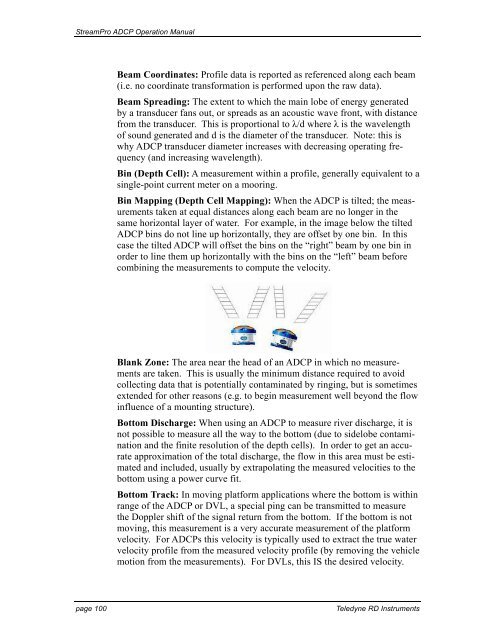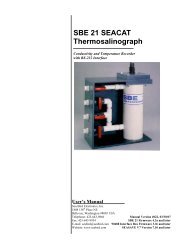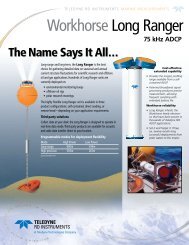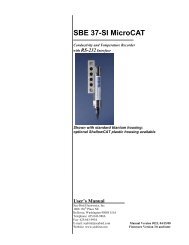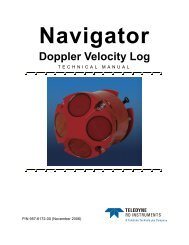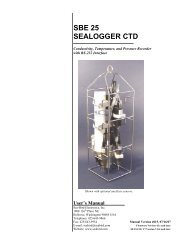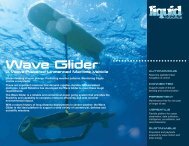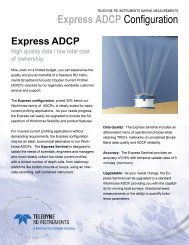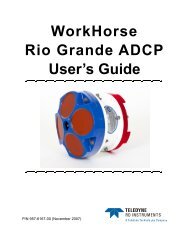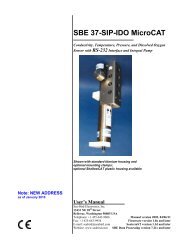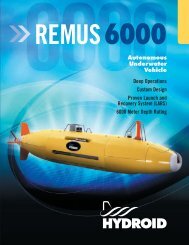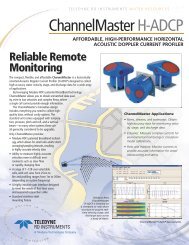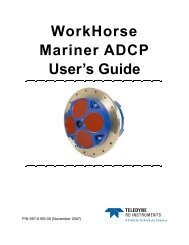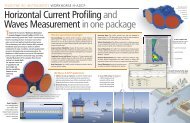StreamPro ADCP Operation Manual - global site
StreamPro ADCP Operation Manual - global site
StreamPro ADCP Operation Manual - global site
- No tags were found...
Create successful ePaper yourself
Turn your PDF publications into a flip-book with our unique Google optimized e-Paper software.
<strong>StreamPro</strong> <strong>ADCP</strong> <strong>Operation</strong> <strong>Manual</strong>Beam Coordinates: Profile data is reported as referenced along each beam(i.e. no coordinate transformation is performed upon the raw data).Beam Spreading: The extent to which the main lobe of energy generatedby a transducer fans out, or spreads as an acoustic wave front, with distancefrom the transducer. This is proportional to λ/d where λ is the wavelengthof sound generated and d is the diameter of the transducer. Note: this iswhy <strong>ADCP</strong> transducer diameter increases with decreasing operating frequency(and increasing wavelength).Bin (Depth Cell): A measurement within a profile, generally equivalent to asingle-point current meter on a mooring.Bin Mapping (Depth Cell Mapping): When the <strong>ADCP</strong> is tilted; the measurementstaken at equal distances along each beam are no longer in thesame horizontal layer of water. For example, in the image below the tilted<strong>ADCP</strong> bins do not line up horizontally, they are offset by one bin. In thiscase the tilted <strong>ADCP</strong> will offset the bins on the “right” beam by one bin inorder to line them up horizontally with the bins on the “left” beam beforecombining the measurements to compute the velocity.Blank Zone: The area near the head of an <strong>ADCP</strong> in which no measurementsare taken. This is usually the minimum distance required to avoidcollecting data that is potentially contaminated by ringing, but is sometimesextended for other reasons (e.g. to begin measurement well beyond the flowinfluence of a mounting structure).Bottom Discharge: When using an <strong>ADCP</strong> to measure river discharge, it isnot possible to measure all the way to the bottom (due to sidelobe contaminationand the finite resolution of the depth cells). In order to get an accurateapproximation of the total discharge, the flow in this area must be estimatedand included, usually by extrapolating the measured velocities to thebottom using a power curve fit.Bottom Track: In moving platform applications where the bottom is withinrange of the <strong>ADCP</strong> or DVL, a special ping can be transmitted to measurethe Doppler shift of the signal return from the bottom. If the bottom is notmoving, this measurement is a very accurate measurement of the platformvelocity. For <strong>ADCP</strong>s this velocity is typically used to extract the true watervelocity profile from the measured velocity profile (by removing the vehiclemotion from the measurements). For DVLs, this IS the desired velocity.page 100Teledyne RD Instruments


